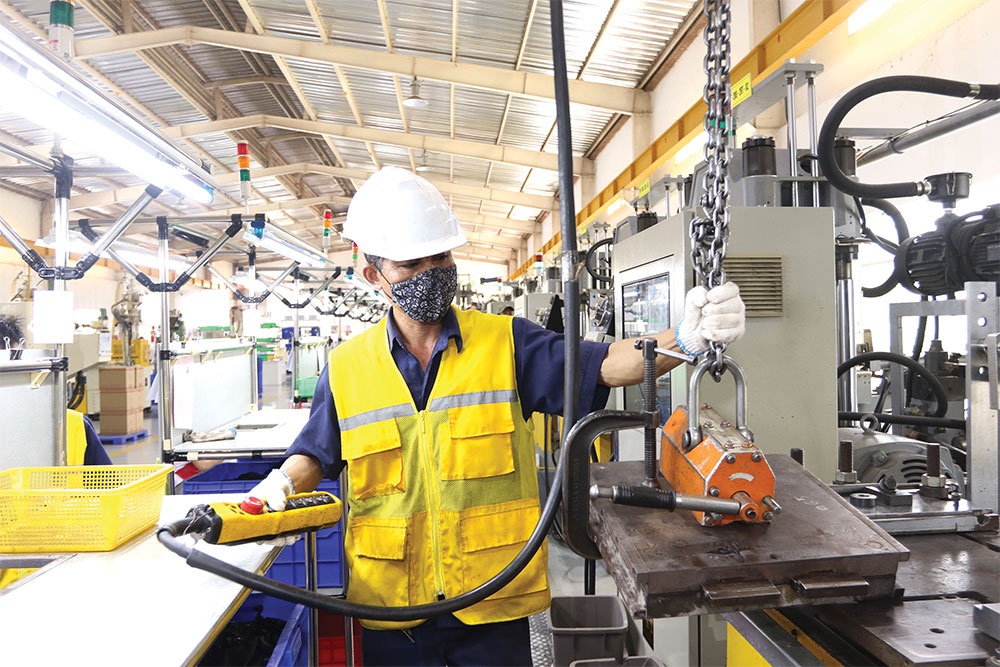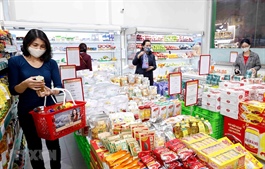Headwinds linger for top production
Headwinds linger for top production
Despite its economy bouncing back gradually, Vietnam’s industrial production is faced with high risks caused by a rise in costs and material shortages, which are undermining the country’s economic outlook.

According to the General Statistics Office (GSO), in the first 11 months of this year, the country’s index for industrial production is estimated to climb 8.6 per cent on-year – far higher than the on-year expansion of 4.2 per cent in the corresponding period last year.
The rate for November is estimated to be merely 0.3 per cent on-month and 5.3 per cent on-year, but which is far lower than the on-year rates of August (13.3 per cent), September (10.3 per cent), and October (5.5 per cent).
“Vietnam’s industrial production increase tends to slow down due to a reduction in enterprises’ orders, high input costs, and shortages of materials,” said the GSO.
For example, the Ministry of Industry and Trade’s Agency of Foreign Trade reported that in the first nine months of this year, the garment and textile industry hit an export turnover of $35 billion, up 21 per cent on-year.
“However, in the third and fourth quarters of this year, the world’s garment and textile market has witnessed a big decrease in orders. The main reason is that the big markets such as the US and the EU have been suffering from high inflation, forcing consumers to tighten their belts including spending on apparel products,” the agency said. “In addition, many markets which are Vietnam’s key trade partners such as China, Japan, and Taiwan have still been applying strict policy on COVID-19 control.”
Issues ahead
Nguyen Viet Thang, vice director of Hanoi Garment and Textile Materials JSC, told VIR that since the end of Q3 of 2022, the company’s materials imported from China have slashed by halved as compared to those in the same period of last year. “This means we have lost orders worth about $700,000, and hundreds of workers have suffered from work reduction,” Thang said. “We have been letting our workers work at the factory four days a week, instead of seven days as before. Many have suggested that companies should shift to importing materials from other sources, but this is easier said than done as it would take a lot of time, effort, and money to find.”
At the government’s cabinet meeting on Vietnam’s 11-month socioeconomic situation, Deputy Minister of Planning and Investment Tran Quoc Phuong stated that despite the economy’s gradual recovery, the country has been facing great pressures caused by global increasingly complicate geopolitical situation and uncertainties in many markets.
“Local industrial production and exports are showing signals of slowdown. Finance and banking are facing increased pressure due to the tightened monetary policies launched by many central banks, and this has had big pressure on the exchange rate, interest rates, and foreign currency in Vietnam,” Phuong noted. “The situation with worker cutbacks and reductions in working hours, as well as workers being off from work on a rotative basis, has returned, meaning performance of many enterprises has become weaker.”
The GSO reported that in November, the whole economy saw nearly 12,000 newly established enterprises registered at $4.54 billion, with 74,000 newly employed labourers. This is down by 8.3 per cent in the number of enterprises, 2.3 per cent in registered capital, and 3.7 per cent in the number of labourers, as compared to those in October.
Also in November, there were more than 4,000 businesses registered to halt performance – down 1.3 per cent on-month but up 13.7 per cent on-year. The month also witnessed nearly 5,100 enterprises wait for conducting dissolution procedures – both up 21.3 and 9.8 per cent; and over 1,400 enterprises complete dissolution procedures – down 11.2 on-month but up 13.2 per cent on-year. “In the first 11 months of 2022, the number of enterprises halting performance is 70,200 – up 34.8 per cent on-year; nearly 45,300 enterprises await dissolution procedures - up 14.7 per cent on-year; and 16,800 enterprises completed all dissolution procedures – up 13.3 per cent on-year. On average, about 12,000 enterprises have withdrew from the market each month,” the GSO stressed.
Risks lingering
The Asian Development Bank (ADB) commented that although the overall business climate in Vietnam has improved so far, “business momentum has started to slow and the registration of new firms declined even though the accumulated number of new firms rose. The decline nevertheless reflects challenges in the business recovery; for example, labour shortages and lower new orders.”
“Vietnam’s economic outlook continues to face heightened risks. The slow delivery of planned public investment and social spending, especially the implementation of the government’s Economic Recovery and Development Programme, could slow growth this year and the next,” said the ADB which in September retained its forecasts for Vietnam’s economy to grow 6.5 per cent this year, followed by an acceleration to 6.7 per cent in 2023.
National Assembly (NA) deputy Nguyen Nhu So, representing the northern province of Bac Ninh, suggested that the legislature and the government needs to enact more solutions to support firms from now until 2023 as many of which are facing massive woes, and this will help the economy grow 6.5 per cent next year.
“It is necessary to focus a priority on removing institutional impediments, especially the operation of the public sector and asset rights including intellectual property rights and administrative quality, so as to ameliorate the economy’s competitiveness and raise the confidence of the public and enterprises,” So said.
“It is also increasingly necessary to change the mindset of institutional reform in a manner in which businesses are regarded as a partner instead of as a managed entity.”
Concerned over headwinds, the NA has set a target that Vietnam’s economic growth for 2023 will be about 6.5 per cent and per capita GDP will be $4,400. The government is expecting the rate will be about 8 per cent for this year.
“Vietnam’s economy is now quite open to the global economy. Thus, any fluctuations in the global market such as high inflation, high prices of materials, and supply chain disruptions can have negative impacts on the Vietnamese country’s macroeconomic stability, economic growth, inflation, and people’s life and incomes,” said Minister of Planning and Investment Nguyen Chi Dung.
According to the GSO’s statistics, Vietnam’s total export-import turnover last year was $668.54 billion, or 1.81 times higher than GDP of $368.68 billion. Total export revenue hit $336.31 billion, up 19 per cent on-year, and import value hit $332.23 billion – up 26.5 per cent on-year.
The Singapore-based ASEAN+3 Macroeconomic Research Office (AMRO), which recently predicted that Vietnam’s GDP growth will rebound to 7 per cent in 2022, underscored risks facing the country’s economic prospects.
“Key external risks stem from global supply chain disruptions, flare-ups in more vaccine-resistant COVID-19 variants, tightening of financial conditions in advanced economies, and elevated global oil and food prices related to geopolitical developments,” said AMRO. “China’s current pandemic approach is likely to continue to strain exports of agricultural products, in addition to creating supply bottlenecks for a range of intermediate goods imports.”
AMRO forecasted that the Vietnamese economy will grow 6.5 per cent in 2023.



















